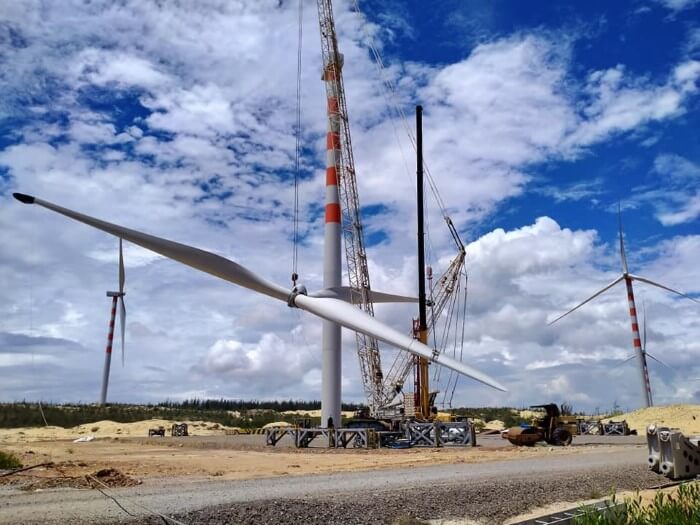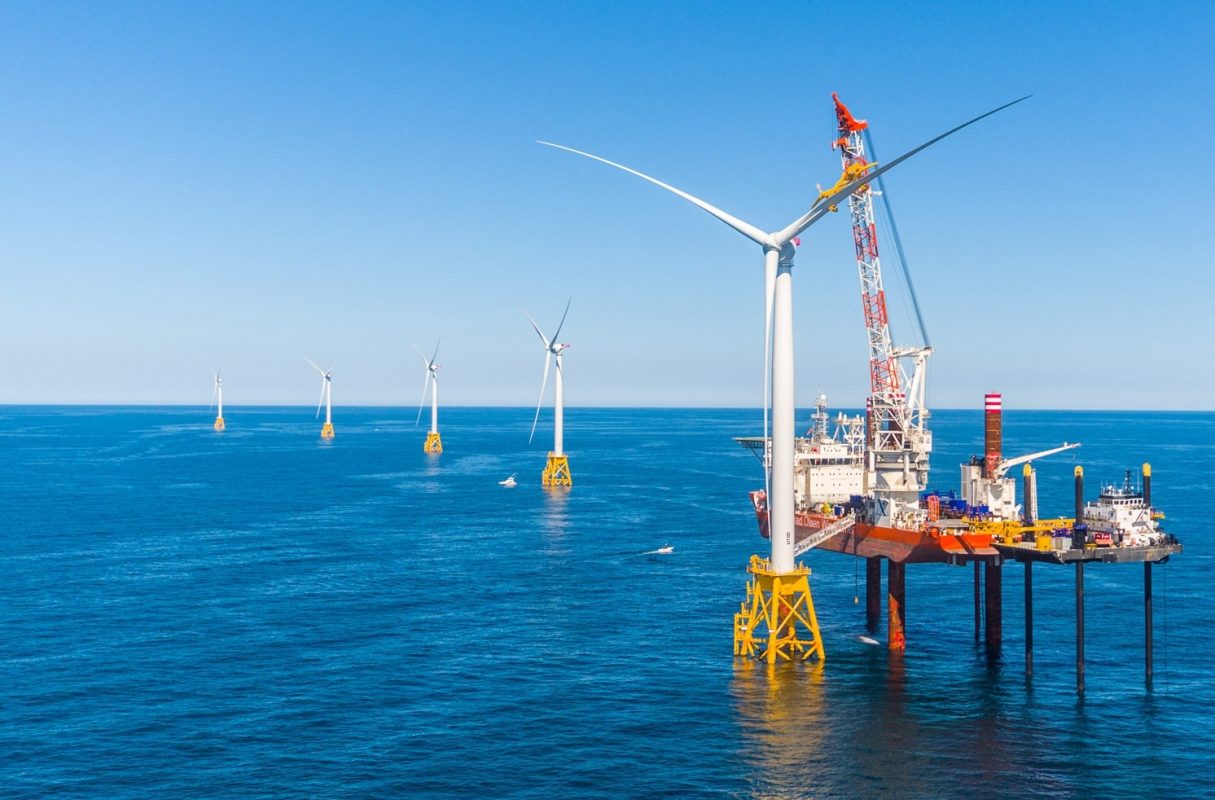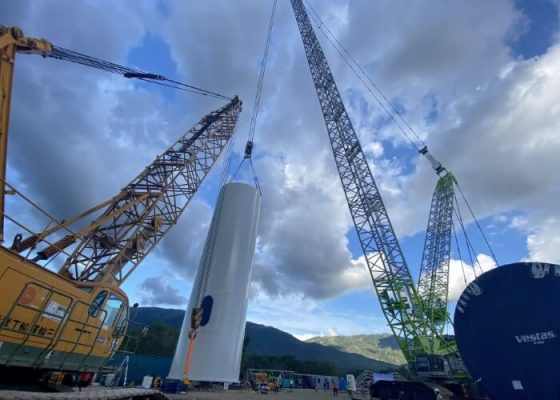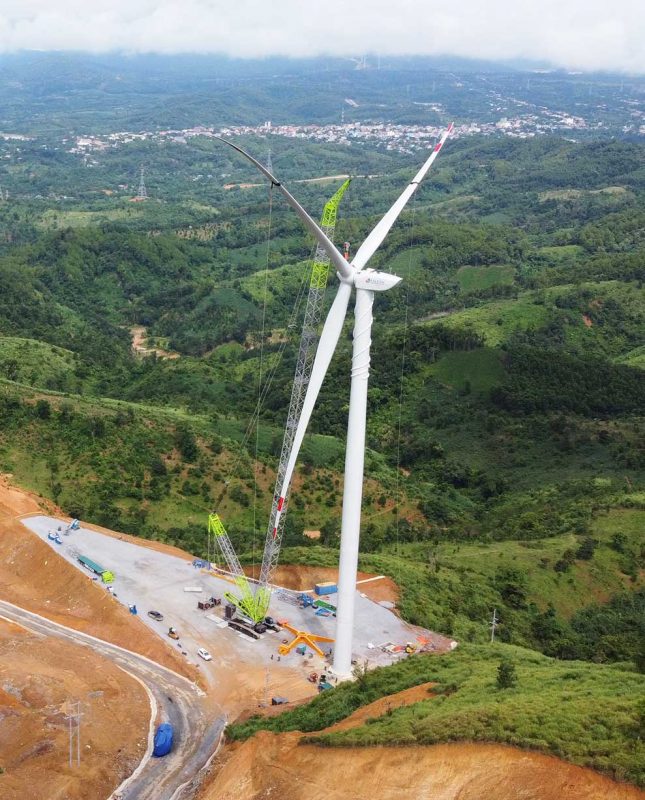Investing in a 1MW wind energy project in Vietnam involves approximately $2 million for onshore wind, with significant expenditures directed towards turbines and infrastructure development.
Costs of Equipment and Wind Turbines
Equipment costs, notably wind turbines, form a major portion of the investment for a 1MW wind energy project in Vietnam, accounting for 60-70% of the total outlay. These turbines are often imported from developed countries like Denmark, Germany, or China, renowned for their advanced wind turbine technologies.
When venturing into wind energy systems, scrutinizing equipment and turbine costs becomes crucial. Commercial wind turbines with capacities ranging from 2-3 MW are priced between $2 and $4 million each, translating to about $1.3 million per MW. Larger scale projects with offshore turbines boasting capacities up to 16-18 MW, though costlier, can curtail the number of turbines needed.
Similarly, small-scale wind turbines for household use, from 1kW to 10kW, have the following price range in Vietnam:
- 400W – 8,000,000 VND
- 1kW – 32,000,000 VND
- 2kW – 46,000,000 VND
- 3kW – 76,000,000 VND
- 5kW – 130,000,000 VND
- 10kW – 198,000,000 VND
Installation costs vary significantly based on system scale, tower height, and geographical location, with larger turbines necessitating higher installation costs. Residential wind turbines typically incur installation expenses of a few thousand to tens of thousands of dollars.
Maintenance of wind turbines is an indispensable consideration. For commercial turbines, annual maintenance costs range from $42,000 to $48,000, approximately 1-2 US cents per kWh produced. However, residential turbines, built with durable designs and corrosion-resistant materials, often reduce maintenance expenses.
Factors determining overall costs extend beyond size and installation site, depending on technology utilized. Advanced technologies like efficient blade designs and modern generator systems can enhance efficiency and slash maintenance costs. Turbines employing fiberglass blades and rust-resistant steel shells also help prolong equipment lifespan.
Residential wind turbines with capacities from 5-15 kW can supply part or all of a household’s electricity needs. However, for optimal operation, wind speeds should reach at least 4 m/s, with efficiency improving as speeds increase, for example, generating around 80 watts at 7 m/s wind speed.

Building Infrastructure and Installation in Wind Energy
Infrastructure development includes activities ranging from constructing power transmission lines, electrical grids, and roads to substations, contributing notably to the 1MW wind energy investment in Vietnam. These tasks demand high technical skills and substantial capital.
Developing a wind energy project requires coordination among various technical aspects and adherence to technical and legal requirements. Beginning with topographic surveys and geotechnical evaluations, these activities lay the groundwork for sturdy turbine foundations. Subsequent foundation design phases ensure load capacity and turbine durability.
Preparation of infrastructure for a wind energy project starts with thorough geotechnical surveys to optimize turbine locations relative to the regional wind map. In the wind energy project development process, these efforts are crucial for operational stability and efficiency.
The next step involves foundation design, accounting for factors like size, materials, and dynamic forces on wind turbines. Particularly, foundations require a minimum two-week curing period before tower erection to ensure concrete stability.
The installation process for wind turbines is equally complex, necessitating large cranes for tower assembly. Upon tower completion, blades, generators, and auxiliary systems are installed and interconnected.
Regarding technical and legal prerequisites, a wind energy project must have wind measurement reports and comprehensive project dossiers. It’s essential to ensure stable grid connections through the electrical transmission system, not only for transmission but also for grid absorption capacity.
Finally, the stages of supervision, trial operation, and maintenance are vital to assessing performance before commercial operation. Regular maintenance activities are essential to sustain system lifespan and efficiency.

Comparing Offshore and Onshore Wind Energy Costs
Offshore wind energy incurs significantly higher investment costs than onshore, due to complex construction conditions, reaching up to $4-5 million/MW. The 1MW wind energy investment in Vietnam is greatly influenced by location and construction conditions.
In renewable energy development, choosing between offshore and onshore wind energy is crucial for investors and technical managers. Onshore wind energy outperforms in installation costs, being 20% cheaper than offshore, thanks to leveraging existing infrastructures and simpler installation technologies.
Installation and Maintenance Costs
- Installation costs: Onshore wind energy takes advantage of existing transmission infrastructure, sharply reducing costs for new wiring and substations. Conversely, offshore wind energy necessitates expansive ocean transmission systems and high safety protocols, leading to higher investment costs.
- Maintenance costs: Another advantage of onshore wind energy is lower maintenance costs due to favorable environmental and geographical conditions. Offshore wind energy, however, involves more complicated and costly maintenance, with annual expenses ranging from $67 to $118/kW.
These strengths underscore the financial benefits of onshore wind energy. For marine environments, offshore wind energy requires specialized personnel and techniques, incurring elevated operational costs, impacting the sustainability of offshore projects.
Expansion Potential and Future Trends
Onshore wind energy demands expansive land near sparsely populated areas, whereas offshore wind energy optimally utilizes the sea, benefiting from stronger winds, enhancing energy production efficiency. Notably, offshore wind energy costs are rapidly declining, dropping by 32% in 2019. Predictions suggest by 2038, these costs may rival or undercut those of fossil energy, narrowing the cost gap with onshore wind energy.
In summary, comparing offshore and onshore wind energy requires evaluating both costs and long-term benefits and feasibility against sustainable development perspectives.

FIT Pricing Scheme for Wind Energy in Vietnam
Vietnam implements an appealing FIT scheme for wind energy: 8.5 US cents/kWh for onshore projects and 9.8 US cents/kWh for offshore projects, according to Decision 39. This encourages considerable investment in renewable energy.
The FIT pricing scheme for wind energy in Vietnam is designed to strongly promote renewable energy investments by offering a fixed purchase price, ensuring financial viability for wind energy projects.
Initially introduced under Decision 37/2011/QĐ-TTg, the FIT price for wind energy was set at 7.8 US cents/kWh excluding VAT, laying the groundwork for attracting investors to new energy markets [1]. Updates from Decision 39/2018/QĐ-TTg applied a revised purchase price for projects operational before 01/11/2021, offering 8.5 US cents/kWh for onshore and 9.8 US cents/kWh for offshore wind. These changes reflect higher investment and operational costs, specifically for offshore projects [1][2][3].
Projects failing to operate before this deadline must adopt the new FIT rates from Decision 21/QĐ-BCT January 2023, lowering prices to 6.8 US cents/kWh for onshore and 7.8 US cents/kWh for offshore wind. This adjustment aims to better manage program finances and prepare for more competitive pricing mechanisms.
The 20-year stable electricity rate, paid at the delivery point, demonstrates long-term commitment and investment appeal. It is converted to VND at current rates, excluding VAT [1][4]. The Ministry of Industry and Trade notes this scheme is based on international experience, intended to spur renewable energy growth in light of rising traditional energy costs [4].
The FIT scheme has achieved notable progress in expanding wind power capacity in Vietnam, particularly post-2018 adjustments, proving effective in encouraging wind energy investments.
Perfecting the FIT pricing scheme for wind energy in Vietnam not only bolsters sustainable renewable energy development but also paves the way for more competitive energy market evolution [1][2][3][4].

Time and Maintenance Costs in Wind Energy
Turbine maintenance in Vietnam costs around $42,000 to $48,000 annually. Project execution time, including permit preparation and assessments, directly affects investment efficiency.
In the wind energy industry, maintenance costs and timing are crucial for ensuring turbine system efficiency. A significant portion of total energy production costs—LCOE—are derived from operations and maintenance (O&M). Maintenance expenses may account for 11% to 25% of total costs. Standard turbines with 2-3 MW capacities typically incur annual maintenance costs of $42,000 – $48,000.
These expenses depend on factors like turbine size, equipment used, system complexity, and location. Larger turbines often result in higher costs. However, adhering to a planned maintenance schedule minimizes unexpected downtime and avoids significant repair expenses.
Maintenance tasks include general inspections, lubricant replacement, tightening mechanical connections, evaluating blade conditions, and immediately addressing minor issues to prevent severe damage. Especially, reactive maintenance methods are generally suitable for short-term cost savings but may lead to greater long-term costs if lacking scheduled upkeep.
Regular maintenance not only extends equipment lifespan but also mitigates serious incident risks. Conversely, establishing a specific cost framework for wind power plant operation and maintenance relies on maintenance costs relative to standard investment and installed capacity, usually 50MW as per Vietnam’s legal standards. This ensures sustainable turbine operation cost control over time.
Ultimately, maintaining a rigorous and planned wind energy maintenance process not only optimizes performance and safety but also becomes a strategic factor in overall energy cost management and project economic effectiveness.

Investing in wind energy projects in Vietnam offers numerous economic and environmental advantages, supported by favorable conditions like attractive FIT schemes and significant development potential. Infrastructure and turbine investments are key to a project’s success.
Contact QuangAnhcons at Hotline: +84 9 1975 8191 for detailed consultation on wind energy project investment and execution in Vietnam.
QuangAnhcons provides comprehensive services from consultation to design and construction of wind energy projects, ensuring quality and investment efficiency by international standards.
[contact-form-7 id="7239967" title="Contact form 1"]


Related Posts
Tay Ninh Solar Power Planning: Technical Framework, Grid Interconnection, and Rollout Roadmap
Technical overview of solar planning in Tay Ninh: irradiation, grid capacity, permitting, design, operations, and [...]
Dec
Binh Duong Solar Planning: Regulatory Framework, Grid Interconnection, and an Implementation Roadmap for Factories and Industrial Parks
An overview of Binh Duong solar planning: legal framework, interconnection, design, risk management, and an [...]
Dec
Solar Farm Repair: O&M Workflow, IV Curve Diagnostics, Thermography, Inverter Service and Utility-Scale Safety
A utility-scale solar farm repair plan centered on O&M, IV curves, thermal imaging, inverter service, [...]
Dec
Dong Nai Solar Power Plan 2023–2025: Tri An 1,029 MW, Grid Upgrades and the DPPA Pathway
A complete look at Dong Nai’s solar power plan: Tri An 1,029 MW, irradiation potential, [...]
Nov
Quang Ngai Solar Power Plan 2024–2030: Legal Framework, Irradiance Potential, and Development Roadmap
A complete look at Quang Ngai’s solar power plan: capacity targets, irradiance (PVout), development zones, [...]
Nov
Solar Damage Assessment Services: On-Site Procedures, EL/IV/Thermography Testing & Compliance with Standards
Discover IEC/UL/NEC standard solar damage assessment processes: on-site evaluation, EL and IV curve testing, thermal [...]
Nov
Comprehensive Package Estimate for a 1800MVA 500kV Substation: Scope, Configuration 3x600MVA, Standards and Timeline Management
An overview of the 1800MVA 500kV substation estimate: construction scope, configuration 3x600MVA, GIS/AIS, SCADA, standards, [...]
Nov
Factory Electrical Systems: Comprehensive Design and Implementation Guide
Discover the detailed and safe process of factory electrical systems design and implementation. [...]
Oct
Blueprints Required for Factory Construction Permits
Discover the necessary blueprints in factory construction permit applications, from floor plans to electrical and [...]
Oct
What Are the Requirements for a Factory Construction Permit? A Comprehensive Guide
Explore the documentation and steps needed to secure a factory construction permit for streamlined project [...]
Oct
Factory Construction Permit Procedures in Vietnam: Essential Guidelines and Documents
Learn the procedures for securing a factory construction permit in Vietnam, focusing on document preparation [...]
Oct
Key Steps in the Factory Construction Process
Discover the essential steps and requirements for building factories. [...]
Oct
Comprehensive Electrical Substation Solutions by Quanganhcons
Discover the cutting-edge electrical substation solutions offered by Quanganhcons for industrial applications. [...]
Oct
Investment Costs for a 1MWp Solar Power System and Influencing Factors
Explore the investment costs for a 1MWp solar power system in Vietnam and the influencing [...]
Sep
QuangAnhcons: Elevating Wind Energy Solutions
Explore QuangAnhcons' leadership in wind energy and renewable solutions in Vietnam. [...]
Sep
Electrical Contractor Strategies at Becamex Industrial Park
Discover the strategic advancements and partnerships of the electrical contractor at Becamex Industrial Park. [...]
Sep
Investment Insights for 1MW Wind Energy in Vietnam: Costs and Opportunities
Discover the detailed analysis of costs and opportunities for investing in 1MW wind energy projects [...]
Sep
Advanced Electrical Installation Solutions by QuangAnhcons
Explore advanced electrical installation solutions and modern technology with QuangAnhcons. [...]
Sep
Enhancing Industrial Electrical Services with Quanganhcons
Discover Quanganhcons' expertise in industrial electrical services, offering efficient and sustainable power systems. [...]
Sep
Comprehensive MEP Solutions by QuangAnhcons: From Design to Maintenance Excellence
Discover optimal MEP solutions with QuangAnhcons, dedicated to excellence from design through maintenance. [...]
Sep